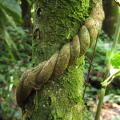
DMT-Nexus member
Posts: 353 Joined: 05-Jun-2019 Last visit: 23-Oct-2023 Location: nammyohorenghekyo
|
Been growing these for a few years, and wanted to share an observation that might or might not be of interest to you guys. I was weeding the herb bed and pulled up a few roots from some two year old desmanthus Illinoensis that had come back from the previous year and went to seed. I peeled some of the root bark off and after about thirty minutes or so noticed that where the bark had been removed from the root cortex, the exposed cortex was turning a very distinct blue color similar to the bruising blue hues one might observe with certain fungi. I'm just a gardener, and not a botanist or a chemist, but thought it was interesting. Reckon that's indole? If so, there was a hell of alot of it.  Author of this Post assumes no Responsibility, nor makes any Guarantee of the Accuracy or Validity of material in this Post. Material Contained or referred to in this Post is presented for Entertainment Purposes Only. This Material IS Not Intended to be Inferred, or Interpreted as Information, Advice, News, Instruction, or Factual Information.
|
|
|
|
|

DMT-Nexus member
Posts: 353 Joined: 05-Jun-2019 Last visit: 23-Oct-2023 Location: nammyohorenghekyo
|
This would have been around Sept. or so (zone 7b), and the seed pods were beginning to turn woody and mature and the foliage was just beginning to brown and die back. The soil they were in is regular old southern Appalachian red clay but they were next to an herb bed that is fairly rich in organic material and moderately acidic, full sun. The previous year they were pretty much choked out by a tangle of P. Incarnata that was rooted in next to them and I had forgotten they were there. They definitely seem to be more prolific their second year as compared to the first, and I had never noticed the bluing before this 'second year' specimen. The bluing was much more pronounced at the top, or higher portions of the exposed root cortex, closest to the main stem. Bundle Flower Blues... sounds like a terrible county song title  Author of this Post assumes no Responsibility, nor makes any Guarantee of the Accuracy or Validity of material in this Post. Material Contained or referred to in this Post is presented for Entertainment Purposes Only. This Material IS Not Intended to be Inferred, or Interpreted as Information, Advice, News, Instruction, or Factual Information.
|
|
|

DMT-Nexus member
Posts: 353 Joined: 05-Jun-2019 Last visit: 23-Oct-2023 Location: nammyohorenghekyo
|
As far as I understand it, Desmanthus illonoesis also seems to contain gramine and dimethyltryptamine in famously variable amounts, and that gramine is a non-tryptamine indole. Remembering what Terrence Mckenna had said about illonoensis, how much of this bluing I noticed would or could have been produced by gramine? I know the amount of gramine is supposed to be minimal, but is it any more apt or quicker to produce the color than the other more desirable indole? If not, then based on my observation and experience with this one, I'd definitely say a few dry days in fall after the seed pods start maturing is an interesting time to observe them. Author of this Post assumes no Responsibility, nor makes any Guarantee of the Accuracy or Validity of material in this Post. Material Contained or referred to in this Post is presented for Entertainment Purposes Only. This Material IS Not Intended to be Inferred, or Interpreted as Information, Advice, News, Instruction, or Factual Information.
|
|
|

❤️🔥
 
Posts: 3648 Joined: 11-Mar-2017 Last visit: 15-Dec-2025 Location: 🌎
|
Can you post pictures? The mushroom blueing is though to come by from the 4-OH phenol oxidation into quinones, but the final form(s) of the degradation product have not been conclusively determined as I understand it and they could depend many things (someone please correct me if I'm wrong). I don't know of a way gramine or DMT could degrade into something blue.
|
|
|

DMT-Nexus member
Posts: 353 Joined: 05-Jun-2019 Last visit: 23-Oct-2023 Location: nammyohorenghekyo
|
I was outside at the time weeding and getting ready for winter so I didn't have a camera to get any pics. If it's helpful though, I will try to get some pics this fall, and maybe pull a few this summer and see if it's a seasonal phenomenon. The blue to blue-green coloring was close if not identical to the color one sees in certain fungi though, I'm pretty certain of that much. Ah well, maybe this observation will prove useful to someone for other reasons, but figured I'd share it. Looks like quinones come from aromatics so I'm guessing the bluing wouldn't be an indicator of more desirable constituents then. If it's high in quinones, that doesn't seem to bode well for the prospects of a 'illinohuasca' but it seems that I've read some positive sounding trip-reports that the authors had apparently lived through. "Chronic (long-term) inhalation exposure to quinone in humans may result in visual disturbances, and chronic dermal contact causes skin ulceration. No information is available on the reproductive, developmental, or carcinogenic effects of quinone in humans." -EPA How dangerous are quinones to a feller who might be in an monoamine inhibited way, as the bluing was pretty pronounced? Anybody know a good reference for what all is bundled in the bundle flower and if any of the compounds might boot this out of the 'acceptable' range for the risk/reward decisions we often make before ingesting something? Also reading rumors that the aerial parts might be of interest? Terrence said it scored the highest of all the samples he tested, I wonder if there's more information on where, when, and how he got his Desmanthus. It's a shame no one pressed him for more details about it. Did history manage to snag that or is lost knowledge? If you dig around a little for seed suppliers, they have literal tote sacks of them on the cheap for grassland planting, and bundleflower is a pretty cool critter. It closes up at night, 'arguably' an attractive plant, it's perennial in a vast range and tough as hell. Leptolobus is said to be more desirable, but it's not as cool IMO. Well dang, when I saw that blue I had a brief but pleasant chill in my soul... Alas. Thanks for the response though, maybe this be valuable to the more quinone-minded.  Author of this Post assumes no Responsibility, nor makes any Guarantee of the Accuracy or Validity of material in this Post. Material Contained or referred to in this Post is presented for Entertainment Purposes Only. This Material IS Not Intended to be Inferred, or Interpreted as Information, Advice, News, Instruction, or Factual Information.
|
|
|

❤️🔥
 
Posts: 3648 Joined: 11-Mar-2017 Last visit: 15-Dec-2025 Location: 🌎
|
I think any quinones from psilocin oxidation are fine because there is a history of use. Don't expect any issues. As for the blue in D. Illinoensis, I did not mean to imply it comes from a quinone. It could be anything, and I have no idea what it could be.
|
|
|

DMT-Nexus member
Posts: 353 Joined: 05-Jun-2019 Last visit: 23-Oct-2023 Location: nammyohorenghekyo
|
https://www.youtube.com/watch?v=YWoHLcHC0oM
34:48 "6% by dry weight N,N-DMT...largest concentration of DMT in any plant..." -Terrence McKenna  Author of this Post assumes no Responsibility, nor makes any Guarantee of the Accuracy or Validity of material in this Post. Material Contained or referred to in this Post is presented for Entertainment Purposes Only. This Material IS Not Intended to be Inferred, or Interpreted as Information, Advice, News, Instruction, or Factual Information.
|
|
|

DMT-Nexus member
Posts: 306 Joined: 04-Mar-2012 Last visit: 20-Jul-2025 Location: temperate dweller
|
Yeah I think this is one of those times Terence was just dead wrong, no idea where he got that figure and I'm not sure he ever sources that claim.
|
|
|
DMT-Nexus member
Posts: 3 Joined: 02-Aug-2019 Last visit: 14-Jul-2023 Location: Hyperspace
|
The Encyclopedia of psychoactive plants (Ratsch) pg 719 Desmanthus Illinoensis (Michx.) MacMillan Root cortex DMT up to 0.34% (illinois bundleflower; cf. Kindscher 1992,239-40)
|
|
|

DMT-Nexus member
Posts: 353 Joined: 05-Jun-2019 Last visit: 23-Oct-2023 Location: nammyohorenghekyo
|
kerelsk wrote:Yeah I think this is one of those times Terence was just dead wrong, no idea where he got that figure and I'm not sure he ever sources that claim. So far I've come across three references by Terrence to this plant, the one I listed, and two other times he mentions that it had the highest DMT content of any plant 'they analyzed', so I would assume the source would be his own research but sadly he didn't elaborate. As common as this plant is and as cold hardy, it's a ringer for cultivation and further study. I've seen the .3% all over the net, but from my limited experience with it, frankly it's very potent and 6% wouldn't surprise me in the least. Author of this Post assumes no Responsibility, nor makes any Guarantee of the Accuracy or Validity of material in this Post. Material Contained or referred to in this Post is presented for Entertainment Purposes Only. This Material IS Not Intended to be Inferred, or Interpreted as Information, Advice, News, Instruction, or Factual Information.
|
|
|

DMT-Nexus member
Posts: 1111 Joined: 18-Feb-2017 Last visit: 12-Jul-2024
|
Is this safe to drink as crude tea and how much rootbark have you guys found to be a good dose?
I've ordered some seeds and look forward to trying it. Would it be responsible to plant in the wild in a zone 9 area where it doesn't grow?
|
|
|

DMT-Nexus member
Posts: 353 Joined: 05-Jun-2019 Last visit: 23-Oct-2023 Location: nammyohorenghekyo
|
Jagube wrote:Is this safe to drink as crude tea and how much rootbark have you guys found to be a good dose?
I've ordered some seeds and look forward to trying it. Would it be responsible to plant in the wild in a zone 9 area where it doesn't grow? I've only worked with it twice, both times were mixed with other sources though and not measured but amounted roughly to the rootbark of two or three two year old roots. I didn't notice any particularly toxic effects aside from purging which I attributed to the Rue seeds not being extracted. I wish I had better information, but it did seem to be very potent and definitely, although subjectively, added to the experience. I wouldn't plant it in the wild if it isn't native, but it is very easily cultivated and seems to actually prefer crappy clay soils, IME. Desmanthus leptolobus might be more appropriate for your area, the seeds are harder to source though. It contains gramine, but the jury is still out on being 'safe' or not. There's some great research on this site in that direction. Author of this Post assumes no Responsibility, nor makes any Guarantee of the Accuracy or Validity of material in this Post. Material Contained or referred to in this Post is presented for Entertainment Purposes Only. This Material IS Not Intended to be Inferred, or Interpreted as Information, Advice, News, Instruction, or Factual Information.
|
|
|

DMT-Nexus member
Posts: 353 Joined: 05-Jun-2019 Last visit: 23-Oct-2023 Location: nammyohorenghekyo
|
https://www.google.com/s...ih=814#spf=1566844245770Author of this Post assumes no Responsibility, nor makes any Guarantee of the Accuracy or Validity of material in this Post. Material Contained or referred to in this Post is presented for Entertainment Purposes Only. This Material IS Not Intended to be Inferred, or Interpreted as Information, Advice, News, Instruction, or Factual Information.
|
|
|

DMT-Nexus member
Posts: 4 Joined: 27-Jul-2019 Last visit: 30-Apr-2020 Location: Your Mamma
|
Thanks for posting.
I’ve been reading up as much as I can on this plant, having noticed it EVERYWHERE in my area recently,
|
|
|

DMT-Nexus member
Posts: 390 Joined: 24-Nov-2018 Last visit: 03-Mar-2024
|
You keep grabbing my attention with this thread, I've got quite a few seedlings inside right now and one out in my yard to see if it fairs through my 5a winter
|
|
|

DMT-Nexus member
Posts: 353 Joined: 05-Jun-2019 Last visit: 23-Oct-2023 Location: nammyohorenghekyo
|
DreadedShaman wrote:You keep grabbing my attention with this thread, I've got quite a few seedlings inside right now and one out in my yard to see if it fairs through my 5a winter As long as it had time to root below the frost line I'd guess they will make it, they are hardy as hell and according to what I've seen, they are listed for 'USDA hardiness: 4-8' and the range maps shows them as far north as the Dakotas in the US which have some pretty brutal winters. I've not found a lot of information about the chemistry of the foliage, seeds, or seed pods out there... might be worth testing as well. Author of this Post assumes no Responsibility, nor makes any Guarantee of the Accuracy or Validity of material in this Post. Material Contained or referred to in this Post is presented for Entertainment Purposes Only. This Material IS Not Intended to be Inferred, or Interpreted as Information, Advice, News, Instruction, or Factual Information.
|
|
|

DMT-Nexus member
Posts: 86 Joined: 20-Dec-2013 Last visit: 24-Apr-2024 Location: The Omniverse
|
In 7b, you should be able to grow D. leptolobus, it's reportedly much more consistent in producing detectable levels of alkaloids than D. illinoensis. Just consider that it's a spreading shrub, rather than a vertically growing one like D. ill., so you'll need to have it in a somewhat open sunny spot to thrive; that said an occasional mow down shouldn't kill it off and may very well encourage root growth. As with D. ill., it's reported to contain relevant levels of alkaloids after 2-3 years of growth.
|
|
|

DMT-Nexus member
Posts: 685 Joined: 08-Jun-2013 Last visit: 04-Mar-2024
|
Psychonaut1969 wrote:The Encyclopedia of psychoactive plants (Ratsch) pg 719 Desmanthus Illinoensis (Michx.) MacMillan Root cortex DMT up to 0.34% (illinois bundleflower; cf. Kindscher 1992,239-40)
Root cortex... Hmmm A while back i sent a sample from an extraction (q21q21 pulled with IPA) and there was no gramine. Trace dmt and a lot of hordenine. Smelled amzing but a disappointing result. Can't seem to get my hands on desmanthus leptobulus seeds. Bundleflowerpower has found it in zone 9. I am zone 8 and it grows well. I think a lot of variables as to when it is most potent. Marijuana, LSD, psilocybin, and DMT they all changed the way I see But love's the only thing that ever saved my life - Sturgill Simpson "Turtles all the Way Down"
Why am I here?
|
|
|

Boundary condition

Posts: 8617 Joined: 30-Aug-2008 Last visit: 29-Nov-2025 Location: square root of minus one
|
Thinking about the blue coloration, it could result from the combination of iron with a phenolic compound (such as hordenine?) “There is a way of manipulating matter and energy so as to produce what modern scientists call 'a field of force'. The field acts on the observer and puts him in a privileged position vis-à-vis the universe. From this position he has access to the realities which are ordinarily hidden from us by time and space, matter and energy. This is what we call the Great Work." ― Jacques Bergier, quoting Fulcanelli
|